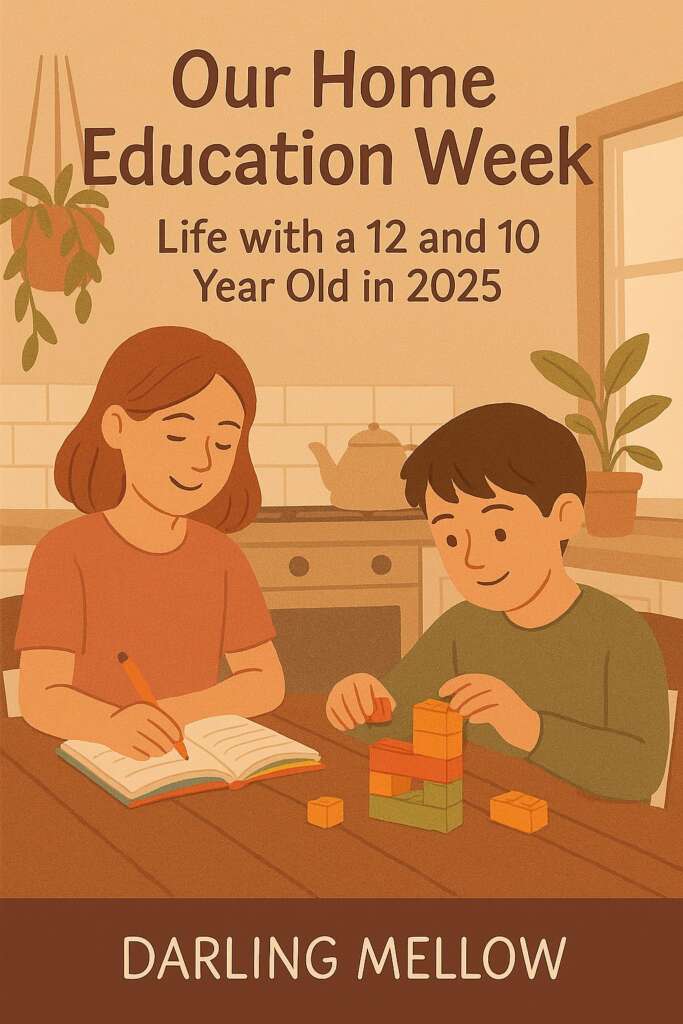Our Home Education Week: Life with a 12 and Almost 10 Year Old
People often ask me what home education actually looks like when you’re living it. Not the Pinterest version with colour-coded timetables, but the real week – the late starts, the rabbit holes, the moments of magic, and the chaos in between. Here’s our honest week right now, with a 12-year-old and an almost 10-year-old learning at home in 2025.
Our week doesn’t follow bells or uniforms – just rhythm, curiosity, and plenty of tea.
Why we work in weeks, not days
I stopped chasing the idea of a perfect “day plan” a long time ago. Some days are a mess no matter how you slice them, but a week always tells the truth. Over the course of seven days, there’s reading, maths, outings, projects, and downtime. It balances out, even if Tuesday was a write-off and Friday turned into pyjamas-all-day. Thinking in weeks instead of days keeps me sane and takes the pressure off the kids, too.
Monday: Easing in
We don’t do Monday morning rushes. The kids start however they want – one curled up with a book, the other sprawled on the floor with art supplies. By mid-morning, we pull together at the table. This term we’ve been working on a local history project. We found an old map that shows hidden rivers under our town. The 12-year-old is fascinated by how places change, while the 10-year-old wants to draw what the streets looked like “before cars ruined it.”
Monday is about setting a tone rather than ticking boxes. We agree on what projects to focus on that week and jot them down in a notebook. It gives us direction without turning into a timetable we’ll ignore by Wednesday anyway.
Tuesday: Out in the world
Tuesdays are our “out day.” It might be the library, a museum, or just a long walk. Recently we went to a science centre where they built rockets out of paper and launched them in the car park. It was loud, chaotic, and unforgettable. Another week we spent hours in the library digging through wildlife guides, and by the evening the kids were teaching me how to identify moths I’ve probably ignored my whole life.
These trips are where learning feels alive. We don’t measure them in worksheets or outcomes – the fact the kids come home buzzing with stories is enough proof for me.
Wednesday: Words and creativity
Midweek is when we catch our breath. My eldest has been writing short stories – her current one involves time travel and a girl who keeps accidentally creating alternate timelines. The almost-10-year-old doesn’t love long writing, so we lean into comics, scripts, and funny captions. This week she wrote a comic strip about a heroic pigeon who saved the town from giant worms. It made us laugh, and that’s reason enough to count it as “English.”
Wednesday afternoons are for creativity in any form – painting, coding, music, or baking. Sometimes they work separately, sometimes together. It’s the day where I remind myself that creativity is a subject in its own right, not a side extra.
Thursday: Core skills (but short and sharp)
If we’re going to lose momentum anywhere, it’s here. Thursday is when we make space for maths, reading, and focused writing. But we keep it short. Twenty minutes, break, another twenty. My eldest prefers using an app for quick practice, while the youngest thrives on real-life maths – baking a cake, working out shopping totals, or converting recipe measurements. It’s fun and it’s the stuff that sticks because it feels real.
By lunchtime we’re usually done, and the afternoon is free for whatever they want – often Roblox, drawing, or a film. It’s balance, not perfection.
Friday: Show and tell (with hot chocolate)
Friday is the highlight of the week. The kids pick one thing they’re proud of – a drawing, a story, a science experiment, or even a Roblox build – and share it. We make hot chocolate, sit together, and listen. It’s simple, but it ends the week on a positive note and teaches them that their work matters. Sometimes they even surprise themselves with how much they’ve done.
The messy middle
I could make it sound glossy, but that wouldn’t be honest. There are days when everyone sulks. There are arguments, missing pencils, and times when I declare “let’s just watch a documentary” because I can’t face another battle. But that’s real life. I’ve stopped seeing those moments as failures. Home education isn’t about being perfect – it’s about having the freedom to adapt when it all goes sideways.
What people always ask us
Do you follow the curriculum?
No. We follow our children. The law requires a “suitable education,” not a copy of school. Some weeks that looks very traditional, other weeks it looks like camping in the garden and learning survival skills.
Do they get social time?
Yes, loads. Between meet-ups, clubs, workshops, and just being part of daily life, they probably interact more broadly than they did in school. They talk to toddlers, teens, adults, and pensioners all in one week. That’s real socialisation.
How do you know they’re learning enough?
Because I see it. They ask better questions, make connections, and explain things back to me. We keep a light portfolio with photos, notes, and projects in case the council ever asks – but the proof is in who they’re becoming, not just what’s on paper.
Why this works for us
At 12 and almost 10, my kids are independent thinkers. Home education gives them the freedom to follow their curiosity, the security of being heard, and the chance to grow without being squeezed into a timetable that doesn’t fit. Our week isn’t perfect, but it’s ours – and that’s more valuable than any grade or target could ever be.

About the Author
Heather is the founder of Darling Mellow, a UK parenting and home education platform. She combines over a decade of parenting experience with modern digital tools to create real, relatable content for mums.
She’s completed accredited courses in Childhood in the Digital Age and Positive Parenting Strategies to ensure every article blends personal insight with evidence-based information.

